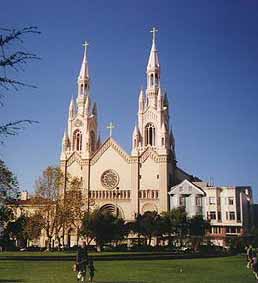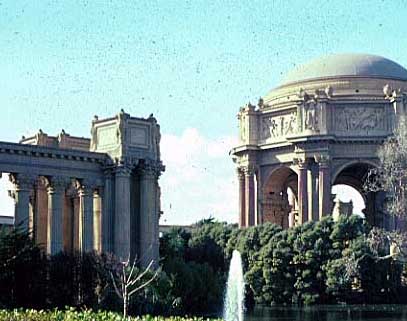An American Architectural Comedy.
by Rory Braddell
Standing in the elegant Huntington
Park on the top of San Francisco's Nob hill, one will
find a small replica of the Notre Dame cathedral. This
miniature, which is dwarfed by the vast buildings that
surround it, is remarkably similar in design to its
Parisian ancestor. It has a central circular rose window
flanked on either side by square bell towers. However,
unlike Notre Dame which is made out of stone, Grace
Cathedral is in fact constructed of reinforced concrete
beaten to achieve a stone like effect. It was constructed
over the years 1928 to 1964 and like many other
neo-gothic buildings in the United States it incorporates
notions of traditional architectural heritage with modern
architectural technique. This mismatch of stylistically
divergent ideas calls to mind the word
“bricolage,” which is defined as something that
is constructed with the use of whatever materials or
styles that come to hand. Past and present are mixed in a
sort of timeless edifice, merging histories, creating a
pastiche that exudes its own artificiality. This feeling
is emphasised by the artificial splendour of the main
doors, which are a true to life replica of Ghiberti's
Baptistry doors in Florence. To anyone with any artistic
sensitivity it is clear that the outside of Grace
Cathedral demonstrates the use of two entirely different
types of architecture. The finest examples of Gothic and
Renaissance architecture are married together in one
building. Similarly the mix and match effect is carried
forth inside Grace Cathedral. Real items, such as a
thirteenth century Catalonian crucifix and a sixteenth
century silk and gold Brussels tapestry, give a certain
edge of credibility to an austere sense of past and
history. However, the stained glass windows, which depict
modern heroes such as Albert Einstein, undermine even
this. Not only are different styles mixed, but also the
distinction between what is “real” and what is
“fake” is no longer discernable. Real elements
are surrounded with an attempt to recreate and
reconstruct history in an effort to make real what is not
there.
|




